2007 ISUZU KB P190 Harness
[x] Cancel search: HarnessPage 1077 of 6020
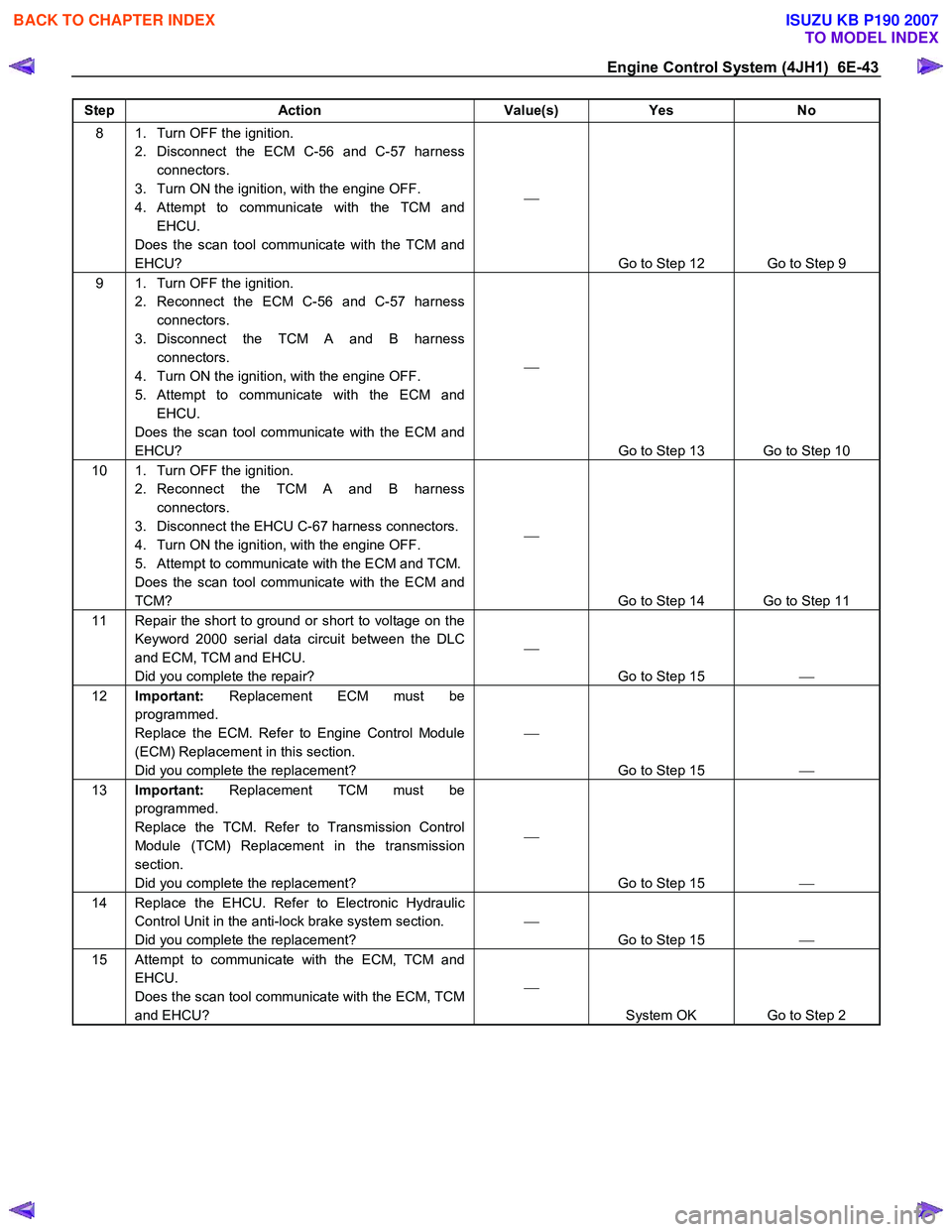
Engine Control System (4JH1) 6E-43
Step Action Value(s) Yes No
8 1. Turn OFF the ignition.
2. Disconnect the ECM C-56 and C-57 harness connectors.
3. Turn ON the ignition, with the engine OFF.
4. Attempt to communicate with the TCM and EHCU.
Does the scan tool communicate with the TCM and
EHCU?
Go to Step 12 Go to Step 9
9 1. Turn OFF the ignition. 2. Reconnect the ECM C-56 and C-57 harness connectors.
3. Disconnect the TCM A and B harness connectors.
4. Turn ON the ignition, with the engine OFF.
5. Attempt to communicate with the ECM and EHCU.
Does the scan tool communicate with the ECM and
EHCU?
Go to Step 13 Go to Step 10
10 1. Turn OFF the ignition. 2. Reconnect the TCM A and B harness connectors.
3. Disconnect the EHCU C-67 harness connectors.
4. Turn ON the ignition, with the engine OFF.
5. Attempt to communicate with the ECM and TCM.
Does the scan tool communicate with the ECM and
TCM?
Go to Step 14 Go to Step 11
11 Repair the short to ground or short to voltage on the Keyword 2000 serial data circuit between the DLC
and ECM, TCM and EHCU.
Did you complete the repair?
Go to Step 15
12 Important: Replacement ECM must be
programmed.
Replace the ECM. Refer to Engine Control Module
(ECM) Replacement in this section.
Did you complete the replacement?
Go to Step 15
13 Important: Replacement TCM must be
programmed.
Replace the TCM. Refer to Transmission Control
Module (TCM) Replacement in the transmission
section.
Did you complete the replacement?
Go to Step 15
14 Replace the EHCU. Refer to Electronic Hydraulic
Control Unit in the anti-lock brake system section.
Did you complete the replacement?
Go to Step 15
15 Attempt to communicate with the ECM, TCM and
EHCU.
Does the scan tool communicate with the ECM, TCM
and EHCU?
System OK Go to Step 2
BACK TO CHAPTER INDEX
TO MODEL INDEX
ISUZU KB P190 2007
Page 1078 of 6020
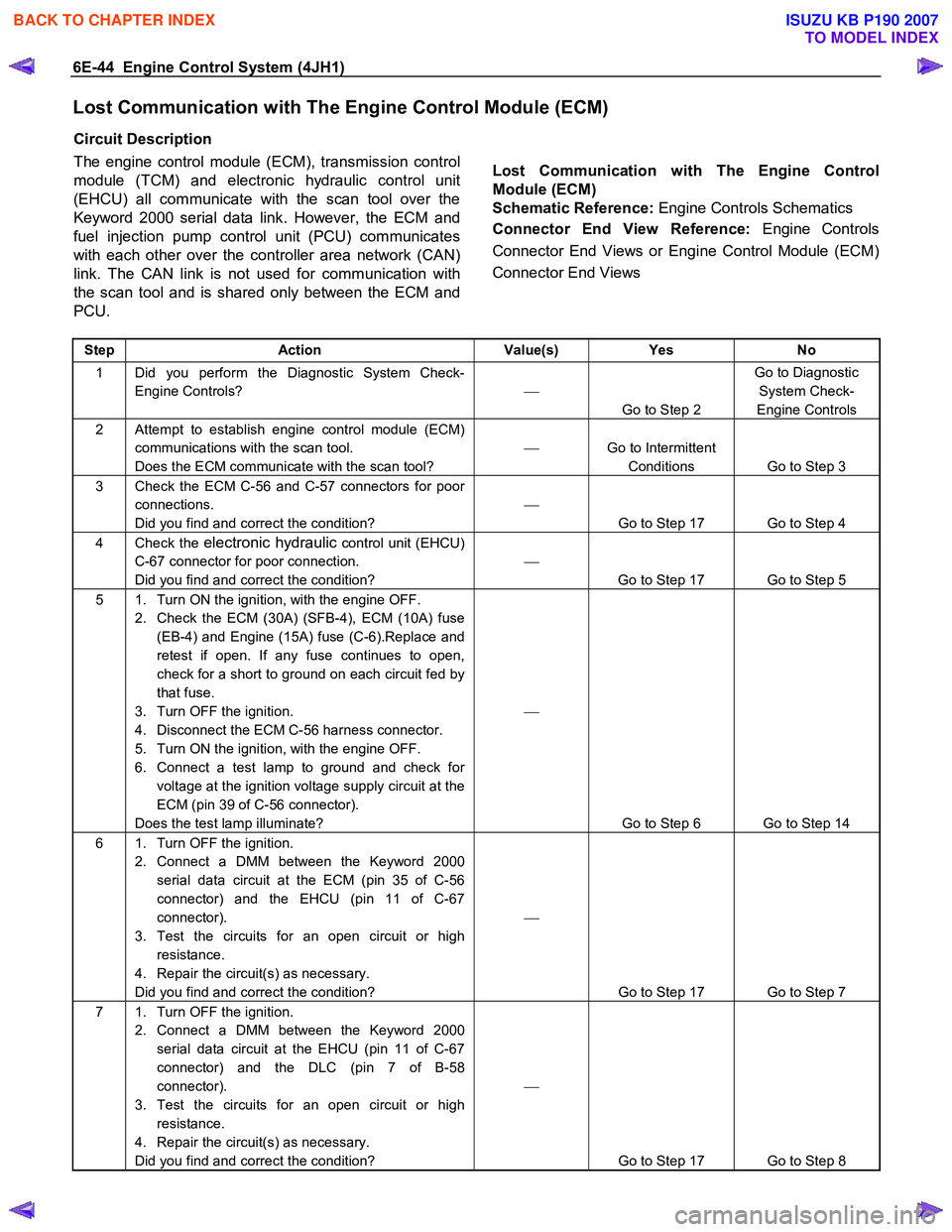
6E-44 Engine Control System (4JH1)
Lost Communication with The Engine Control Module (ECM)
Circuit Description
The engine control module (ECM), transmission control
module (TCM) and electronic hydraulic control unit
(EHCU) all communicate with the scan tool over the
Keyword 2000 serial data link. However, the ECM and
fuel injection pump control unit (PCU) communicates
with each other over the controller area network (CAN)
link. The CAN link is not used for communication with
the scan tool and is shared only between the ECM and
PCU.
Lost Communication with The Engine Control
Module (ECM)
Schematic Reference: Engine Controls Schematics
Connector End View Reference: Engine Controls
Connector End Views or Engine Control Module (ECM)
Connector End Views
Step Action Value(s) Yes No
1 Did you perform the Diagnostic System Check-
Engine Controls?
Go to Step 2 Go to Diagnostic
System Check-
Engine Controls
2 Attempt to establish engine control module (ECM) communications with the scan tool.
Does the ECM communicate with the scan tool?
Go to Intermittent
Conditions Go to Step 3
3 Check the ECM C-56 and C-57 connectors for poor connections.
Did you find and correct the condition?
Go to Step 17 Go to Step 4
4 Check the electronic hydraulic control unit (EHCU)
C-67 connector for poor connection.
Did you find and correct the condition?
Go to Step 17 Go to Step 5
5 1. Turn ON the ignition, with the engine OFF. 2. Check the ECM (30A) (SFB-4), ECM (10A) fuse (EB-4) and Engine (15A) fuse (C-6).Replace and
retest if open. If any fuse continues to open,
check for a short to ground on each circuit fed by
that fuse.
3. Turn OFF the ignition.
4. Disconnect the ECM C-56 harness connector.
5. Turn ON the ignition, with the engine OFF.
6. Connect a test lamp to ground and check for voltage at the ignition voltage supply circuit at the
ECM (pin 39 of C-56 connector).
Does the test lamp illuminate?
Go to Step 6 Go to Step 14
6 1. Turn OFF the ignition. 2. Connect a DMM between the Keyword 2000 serial data circuit at the ECM (pin 35 of C-56
connector) and the EHCU (pin 11 of C-67
connector).
3. Test the circuits for an open circuit or high resistance.
4. Repair the circuit(s) as necessary.
Did you find and correct the condition?
Go to Step 17 Go to Step 7
7 1. Turn OFF the ignition. 2. Connect a DMM between the Keyword 2000 serial data circuit at the EHCU (pin 11 of C-67
connector) and the DLC (pin 7 of B-58
connector).
3. Test the circuits for an open circuit or high resistance.
4. Repair the circuit(s) as necessary.
Did you find and correct the condition?
Go to Step 17 Go to Step 8
BACK TO CHAPTER INDEX
TO MODEL INDEX
ISUZU KB P190 2007
Page 1079 of 6020
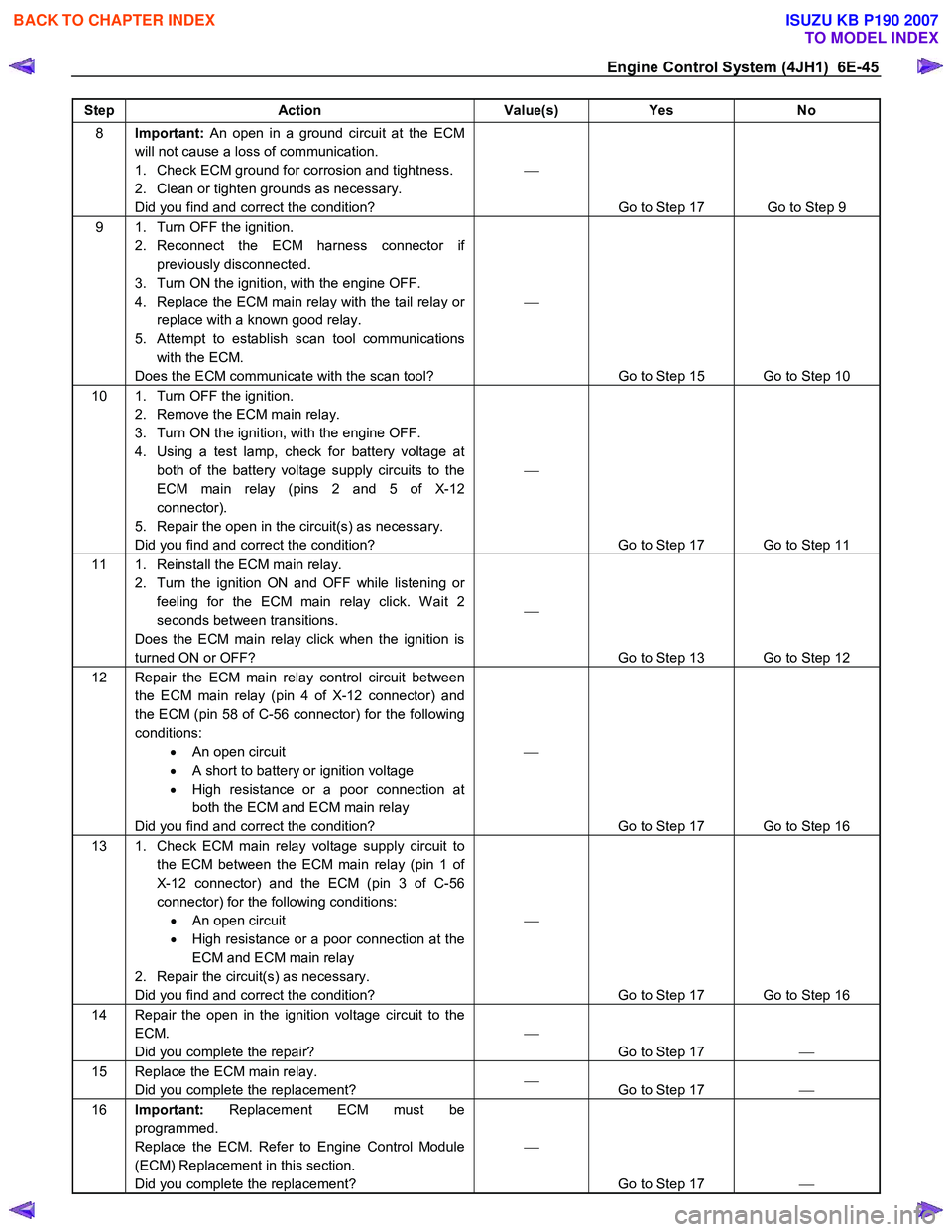
Engine Control System (4JH1) 6E-45
Step Action Value(s) Yes No
8 Important: An open in a ground circuit at the ECM
will not cause a loss of communication.
1. Check ECM ground for corrosion and tightness.
2. Clean or tighten grounds as necessary.
Did you find and correct the condition?
Go to Step 17 Go to Step 9
9 1. Turn OFF the ignition. 2. Reconnect the ECM harness connector if previously disconnected.
3. Turn ON the ignition, with the engine OFF.
4. Replace the ECM main relay with the tail relay or replace with a known good relay.
5. Attempt to establish scan tool communications with the ECM.
Does the ECM communicate with the scan tool?
Go to Step 15 Go to Step 10
10 1. Turn OFF the ignition. 2. Remove the ECM main relay.
3. Turn ON the ignition, with the engine OFF.
4. Using a test lamp, check for battery voltage at both of the battery voltage supply circuits to the
ECM main relay (pins 2 and 5 of X-12
connector).
5. Repair the open in the circuit(s) as necessary.
Did you find and correct the condition?
Go to Step 17 Go to Step 11
11 1. Reinstall the ECM main relay. 2. Turn the ignition ON and OFF while listening or feeling for the ECM main relay click. W ait 2
seconds between transitions.
Does the ECM main relay click when the ignition is
turned ON or OFF?
Go to Step 13 Go to Step 12
12 Repair the ECM main relay control circuit between the ECM main relay (pin 4 of X-12 connector) and
the ECM (pin 58 of C-56 connector) for the following
conditions: • An open circuit
• A short to battery or ignition voltage
• High resistance or a poor connection at
both the ECM and ECM main relay
Did you find and correct the condition?
Go to Step 17 Go to Step 16
13 1. Check ECM main relay voltage supply circuit to the ECM between the ECM main relay (pin 1 of
X-12 connector) and the ECM (pin 3 of C-56
connector) for the following conditions: • An open circuit
• High resistance or a poor connection at the
ECM and ECM main relay
2. Repair the circuit(s) as necessary.
Did you find and correct the condition?
Go to Step 17 Go to Step 16
14 Repair the open in the ignition voltage circuit to the ECM.
Did you complete the repair?
Go to Step 17
15 Replace the ECM main relay.
Did you complete the replacement?
Go to Step 17
16 Important: Replacement ECM must be
programmed.
Replace the ECM. Refer to Engine Control Module
(ECM) Replacement in this section.
Did you complete the replacement?
Go to Step 17
BACK TO CHAPTER INDEX
TO MODEL INDEX
ISUZU KB P190 2007
Page 1083 of 6020
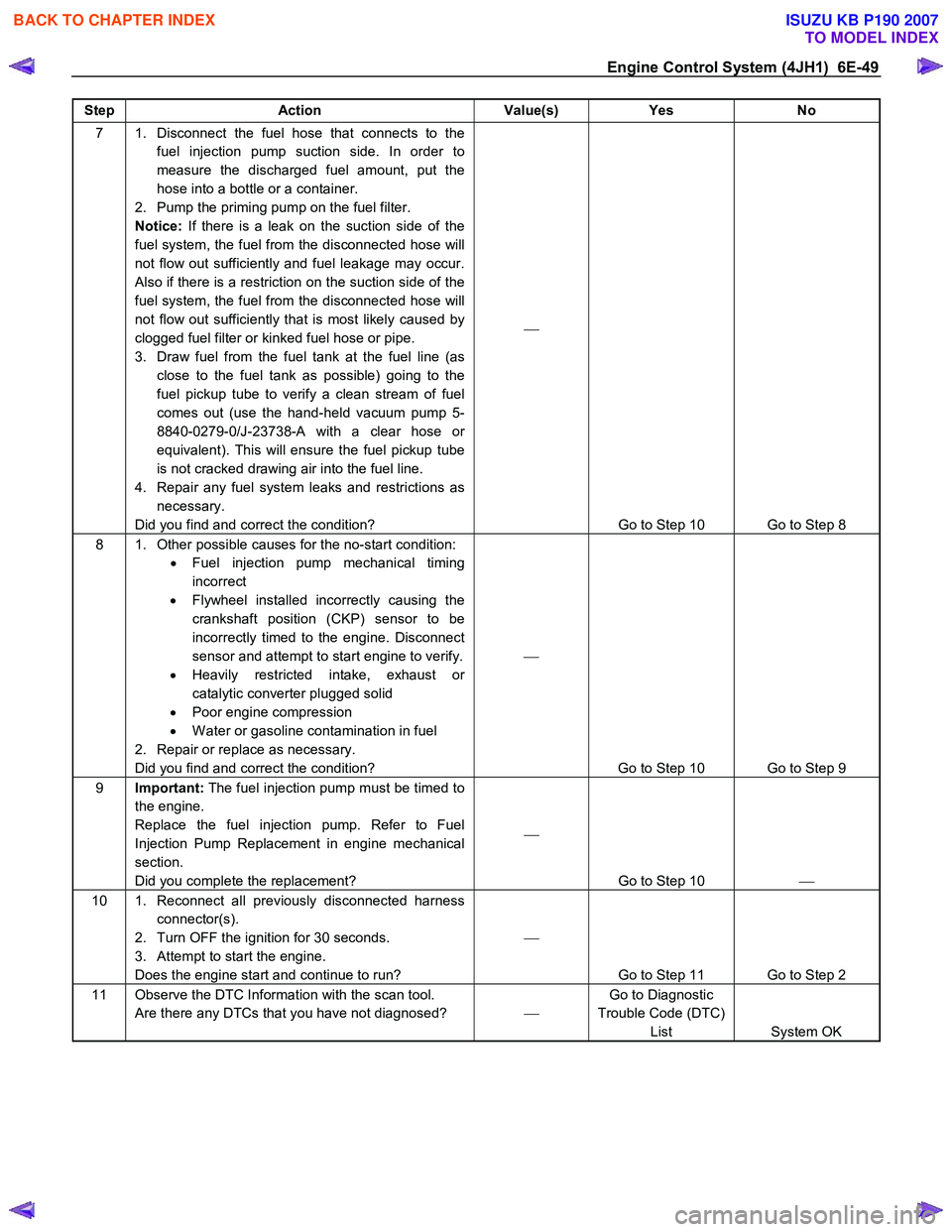
Engine Control System (4JH1) 6E-49
Step Action Value(s) Yes No
7 1. Disconnect the fuel hose that connects to the
fuel injection pump suction side. In order to
measure the discharged fuel amount, put the
hose into a bottle or a container.
2. Pump the priming pump on the fuel filter.
Notice: If there is a leak on the suction side of the
fuel system, the fuel from the disconnected hose will
not flow out sufficiently and fuel leakage may occur.
Also if there is a restriction on the suction side of the
fuel system, the fuel from the disconnected hose will
not flow out sufficiently that is most likely caused by
clogged fuel filter or kinked fuel hose or pipe.
3. Draw fuel from the fuel tank at the fuel line (as close to the fuel tank as possible) going to the
fuel pickup tube to verify a clean stream of fuel
comes out (use the hand-held vacuum pump 5-
8840-0279-0/J-23738-A with a clear hose or
equivalent). This will ensure the fuel pickup tube
is not cracked drawing air into the fuel line.
4. Repair any fuel system leaks and restrictions as necessary.
Did you find and correct the condition?
Go to Step 10 Go to Step 8
8 1. Other possible causes for the no-start condition: • Fuel injection pump mechanical timing
incorrect
• Flywheel installed incorrectly causing the
crankshaft position (CKP) sensor to be
incorrectly timed to the engine. Disconnect
sensor and attempt to start engine to verify.
• Heavily restricted intake, exhaust or
catalytic converter plugged solid
• Poor engine compression
• W ater or gasoline contamination in fuel
2. Repair or replace as necessary.
Did you find and correct the condition?
Go to Step 10 Go to Step 9
9 Important: The fuel injection pump must be timed to
the engine.
Replace the fuel injection pump. Refer to Fuel
Injection Pump Replacement in engine mechanical
section.
Did you complete the replacement?
Go to Step 10
10 1. Reconnect all previously disconnected harness
connector(s).
2. Turn OFF the ignition for 30 seconds.
3. Attempt to start the engine.
Does the engine start and continue to run?
Go to Step 11 Go to Step 2
11 Observe the DTC Information with the scan tool. Are there any DTCs that you have not diagnosed? Go to Diagnostic
Trouble Code (DTC) List System OK
BACK TO CHAPTER INDEX
TO MODEL INDEX
ISUZU KB P190 2007
Page 1084 of 6020

6E-50 Engine Control System (4JH1)
Diagnostic Trouble Code (DTC) List
DTC
(Symptom Code) Flash
Code MIL
Status DTC Name on
scan tool Condition for
Running the DTC Condition for
Setting the DTC Possible Cause
P0100
(7) 65 ON Mass Air Flow
(MAF) Sensor
Circuit 5V
Reference High
Voltage •
The ignition switch
is ON.
•
The ECM detects
that the MAF sensor
5 volts reference
circuit voltage is
more than 5.2 volts
for 0.5 seconds. •
Sensor 5V reference circuit is
short to battery or ignition
voltage.
• Sensor 5V reference circuit is
short to the sensor ignition
voltage circuit.
• Faulty MAF sensor.
• Faulty ECM.
P0100 (9) 65 ON Mass Air Flow
(MAF) Sensor
Voltage 5V
Reference Circuit
Low Voltage •
The ignition switch
is ON.
•
The ECM detects
that the MAF sensor
5 volts reference
circuit voltage is
less than 4.6 volts
for 0.5 seconds. •
Sensor 5V reference circuit is
short to ground.
• Sensor 5V reference circuit is
short to the low reference circuit.
• Faulty MAF sensor.
• Faulty ECM.
P0100 (B) 65 ON Mass Air Flow
(MAF) Sensor
Circuit Low
Voltage •
The ignition switch
is ON.
• The engine is
running.
•
The ECM calculated
MAF is lower than -
18.6 kg/h for 5
seconds.
•
ECM (10A) fuse (EB1) open.
• Sensor ignition voltage feed
circuit is open circuit or high
resistance.
• Sensor 5V reference circuit is
open circuit, high resistance,
short to ground or short to the
low reference circuit.
• Sensor signal circuit is open
circuit, high resistance, short to
ground or short to the low
reference circuit.
• Poor harness connector
connection.
• Faulty MAF sensor installation.
• Faulty MAF sensor.
• Faulty ECM.
P0100 (C) 65 ON Mass Air Flow
(MAF) Sensor
Circuit High
Voltage •
The ignition switch
is ON.
• The engine is
running.
•
The ECM calculated
MAF is higher than
984 kg/h for 10
seconds.
•
Sensor signal circuit is short to
any 5V reference circuit, short to
battery or ignition voltage circuit.
• Sensor low reference circuit is
open circuit or high resistance.
• Poor harness connector
connection.
• Faulty MAF sensor.
• Faulty ECM.
P0105 (1) 34 ON Vacuum Pressure
Sensor Circuit
High Voltage •
The ignition switch
is ON. •
The ECM detects
that the vacuum
pressure sensor
signal voltage is
more than 4.4 volts
for 3 seconds. •
Sensor 5V reference circuit is
short to battery or ignition
voltage.
• Sensor signal circuit is short to
any 5V reference circuit, short to
battery or ignition voltage.
• Sensor low reference circuit is
open circuit or high resistance.
• Poor harness connector
connection.
• Faulty vacuum pressure sensor.
• Faulty ECM.
BACK TO CHAPTER INDEX
TO MODEL INDEX
ISUZU KB P190 2007
Page 1085 of 6020
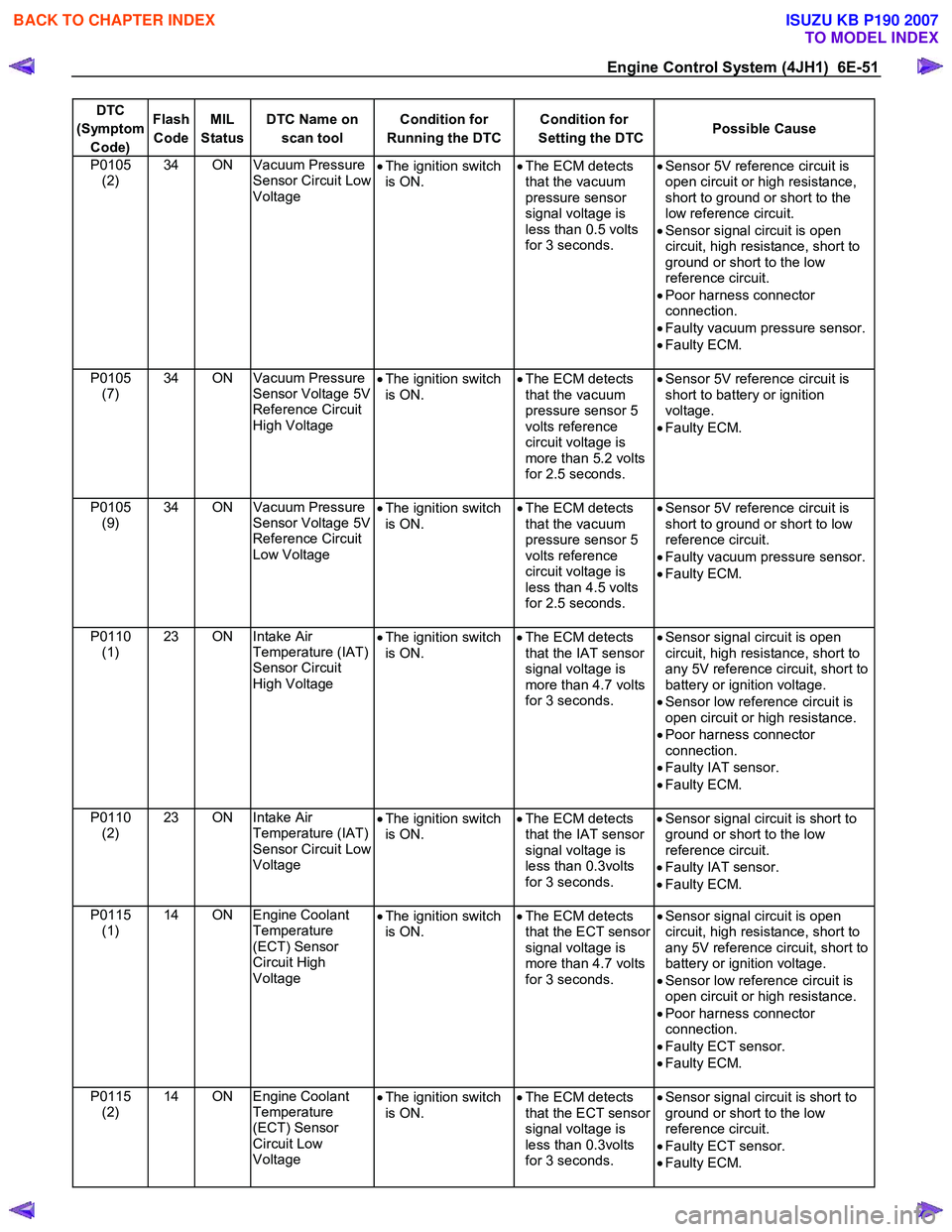
Engine Control System (4JH1) 6E-51
DTC
(Symptom Code) Flash
Code MIL
Status DTC Name on
scan tool Condition for
Running the DTC Condition for
Setting the DTC Possible Cause
P0105
(2) 34 ON Vacuum Pressure
Sensor Circuit Low
Voltage •
The ignition switch
is ON. •
The ECM detects
that the vacuum
pressure sensor
signal voltage is
less than 0.5 volts
for 3 seconds. •
Sensor 5V reference circuit is
open circuit or high resistance,
short to ground or short to the
low reference circuit.
• Sensor signal circuit is open
circuit, high resistance, short to
ground or short to the low
reference circuit.
• Poor harness connector
connection.
• Faulty vacuum pressure sensor.
• Faulty ECM.
P0105 (7) 34 ON Vacuum Pressure
Sensor Voltage 5V
Reference Circuit
High Voltage
•
The ignition switch
is ON. •
The ECM detects
that the vacuum
pressure sensor 5
volts reference
circuit voltage is
more than 5.2 volts
for 2.5 seconds.
•
Sensor 5V reference circuit is
short to battery or ignition
voltage.
• Faulty ECM.
P0105 (9) 34 ON Vacuum Pressure
Sensor Voltage 5V
Reference Circuit
Low Voltage
•
The ignition switch
is ON. •
The ECM detects
that the vacuum
pressure sensor 5
volts reference
circuit voltage is
less than 4.5 volts
for 2.5 seconds.
•
Sensor 5V reference circuit is
short to ground or short to low
reference circuit.
• Faulty vacuum pressure sensor.
• Faulty ECM.
P0110 (1) 23 ON Intake Air
Temperature (IAT)
Sensor Circuit
High Voltage •
The ignition switch
is ON.
•
The ECM detects
that the IAT sensor
signal voltage is
more than 4.7 volts
for 3 seconds. •
Sensor signal circuit is open
circuit, high resistance, short to
any 5V reference circuit, short to
battery or ignition voltage.
• Sensor low reference circuit is
open circuit or high resistance.
• Poor harness connector
connection.
• Faulty IAT sensor.
• Faulty ECM.
P0110 (2) 23 ON Intake Air
Temperature (IAT)
Sensor Circuit Low
Voltage
•
The ignition switch
is ON.
•
The ECM detects
that the IAT sensor
signal voltage is
less than 0.3volts
for 3 seconds.
•
Sensor signal circuit is short to
ground or short to the low
reference circuit.
• Faulty IAT sensor.
• Faulty ECM.
P0115
(1) 14 ON Engine Coolant
Temperature
(ECT) Sensor
Circuit High
Voltage •
The ignition switch
is ON.
•
The ECM detects
that the ECT sensor
signal voltage is
more than 4.7 volts
for 3 seconds. •
Sensor signal circuit is open
circuit, high resistance, short to
any 5V reference circuit, short to
battery or ignition voltage.
• Sensor low reference circuit is
open circuit or high resistance.
• Poor harness connector
connection.
• Faulty ECT sensor.
• Faulty ECM.
P0115 (2) 14 ON Engine Coolant
Temperature
(ECT) Sensor
Circuit Low
Voltage
•
The ignition switch
is ON.
•
The ECM detects
that the ECT sensor
signal voltage is
less than 0.3volts
for 3 seconds. •
Sensor signal circuit is short to
ground or short to the low
reference circuit.
• Faulty ECT sensor.
• Faulty ECM.
BACK TO CHAPTER INDEX
TO MODEL INDEX
ISUZU KB P190 2007
Page 1087 of 6020
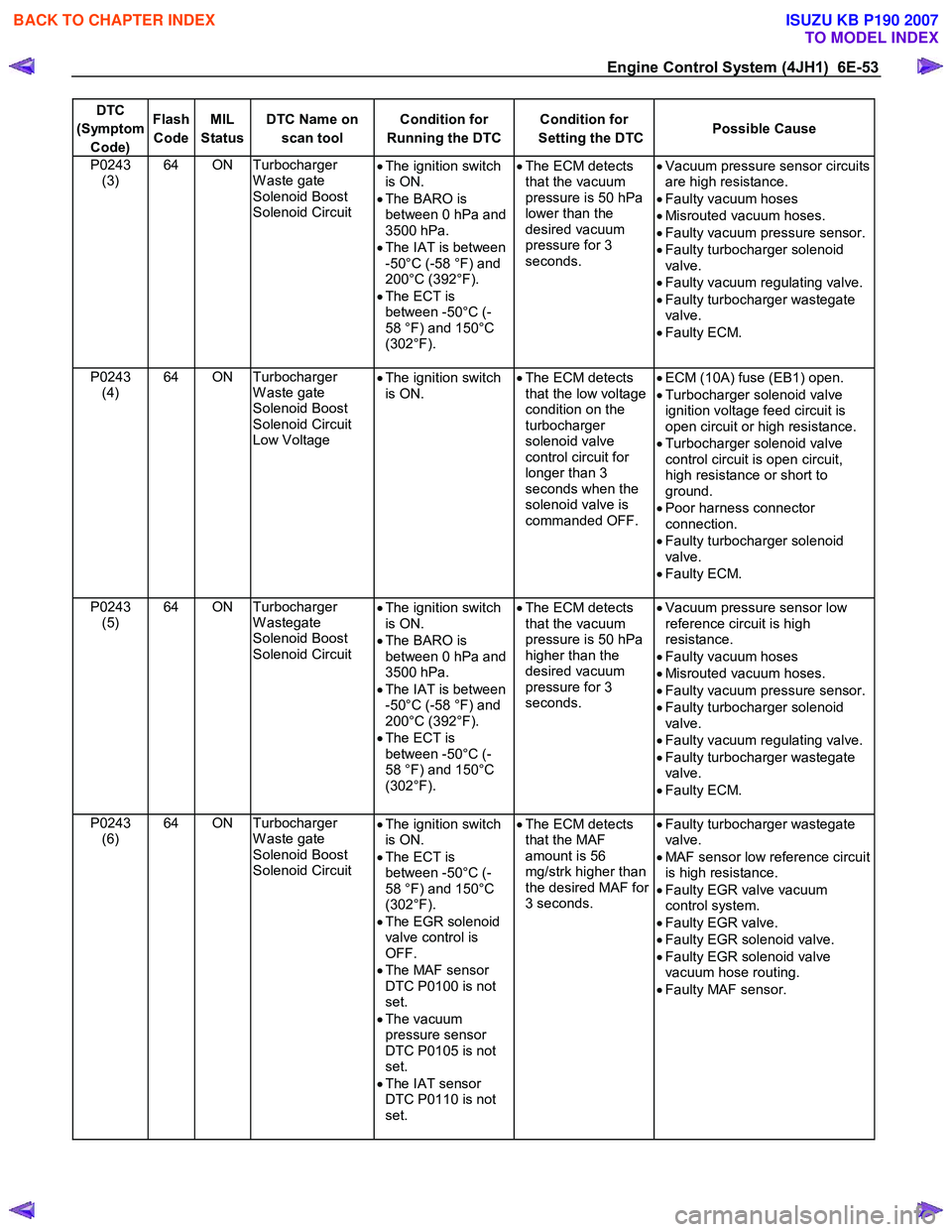
Engine Control System (4JH1) 6E-53
DTC
(Symptom Code) Flash
Code MIL
Status DTC Name on
scan tool Condition for
Running the DTC Condition for
Setting the DTC Possible Cause
P0243
(3) 64 ON Turbocharger
W aste gate
Solenoid Boost
Solenoid Circuit •
The ignition switch
is ON.
• The BARO is
between 0 hPa and
3500 hPa.
• The IAT is between
-50°C (-58 °F) and
200°C (392°F).
• The ECT is
between -50°C (-
58 °F) and 150°C
(302°F).
•
The ECM detects
that the vacuum
pressure is 50 hPa
lower than the
desired vacuum
pressure for 3
seconds.
•
Vacuum pressure sensor circuits
are high resistance.
• Faulty vacuum hoses
• Misrouted vacuum hoses.
• Faulty vacuum pressure sensor.
• Faulty turbocharger solenoid
valve.
• Faulty vacuum regulating valve.
• Faulty turbocharger wastegate
valve.
• Faulty ECM.
P0243 (4) 64 ON Turbocharger
W aste gate
Solenoid Boost
Solenoid Circuit
Low Voltage •
The ignition switch
is ON.
•
The ECM detects
that the low voltage
condition on the
turbocharger
solenoid valve
control circuit for
longer than 3
seconds when the
solenoid valve is
commanded OFF.
•
ECM (10A) fuse (EB1) open.
• Turbocharger solenoid valve
ignition voltage feed circuit is
open circuit or high resistance.
• Turbocharger solenoid valve
control circuit is open circuit,
high resistance or short to
ground.
• Poor harness connector
connection.
• Faulty turbocharger solenoid
valve.
• Faulty ECM.
P0243 (5) 64 ON Turbocharger
W astegate
Solenoid Boost
Solenoid Circuit •
The ignition switch
is ON.
• The BARO is
between 0 hPa and
3500 hPa.
• The IAT is between
-50°C (-58 °F) and
200°C (392°F).
• The ECT is
between -50°C (-
58 °F) and 150°C
(302°F).
•
The ECM detects
that the vacuum
pressure is 50 hPa
higher than the
desired vacuum
pressure for 3
seconds.
•
Vacuum pressure sensor low
reference circuit is high
resistance.
• Faulty vacuum hoses
• Misrouted vacuum hoses.
• Faulty vacuum pressure sensor.
• Faulty turbocharger solenoid
valve.
• Faulty vacuum regulating valve.
• Faulty turbocharger wastegate
valve.
• Faulty ECM.
P0243 (6) 64 ON Turbocharger
W aste gate
Solenoid Boost
Solenoid Circuit •
The ignition switch
is ON.
• The ECT is
between -50°C (-
58 °F) and 150°C
(302°F).
• The EGR solenoid
valve control is
OFF.
• The MAF sensor
DTC P0100 is not
set.
• The vacuum
pressure sensor
DTC P0105 is not
set.
• The IAT sensor
DTC P0110 is not
set.
•
The ECM detects
that the MAF
amount is 56
mg/strk higher than
the desired MAF for
3 seconds.
•
Faulty turbocharger wastegate
valve.
• MAF sensor low reference circuit
is high resistance.
• Faulty EGR valve vacuum
control system.
• Faulty EGR valve.
• Faulty EGR solenoid valve.
• Faulty EGR solenoid valve
vacuum hose routing.
• Faulty MAF sensor.
BACK TO CHAPTER INDEX
TO MODEL INDEX
ISUZU KB P190 2007
Page 1090 of 6020
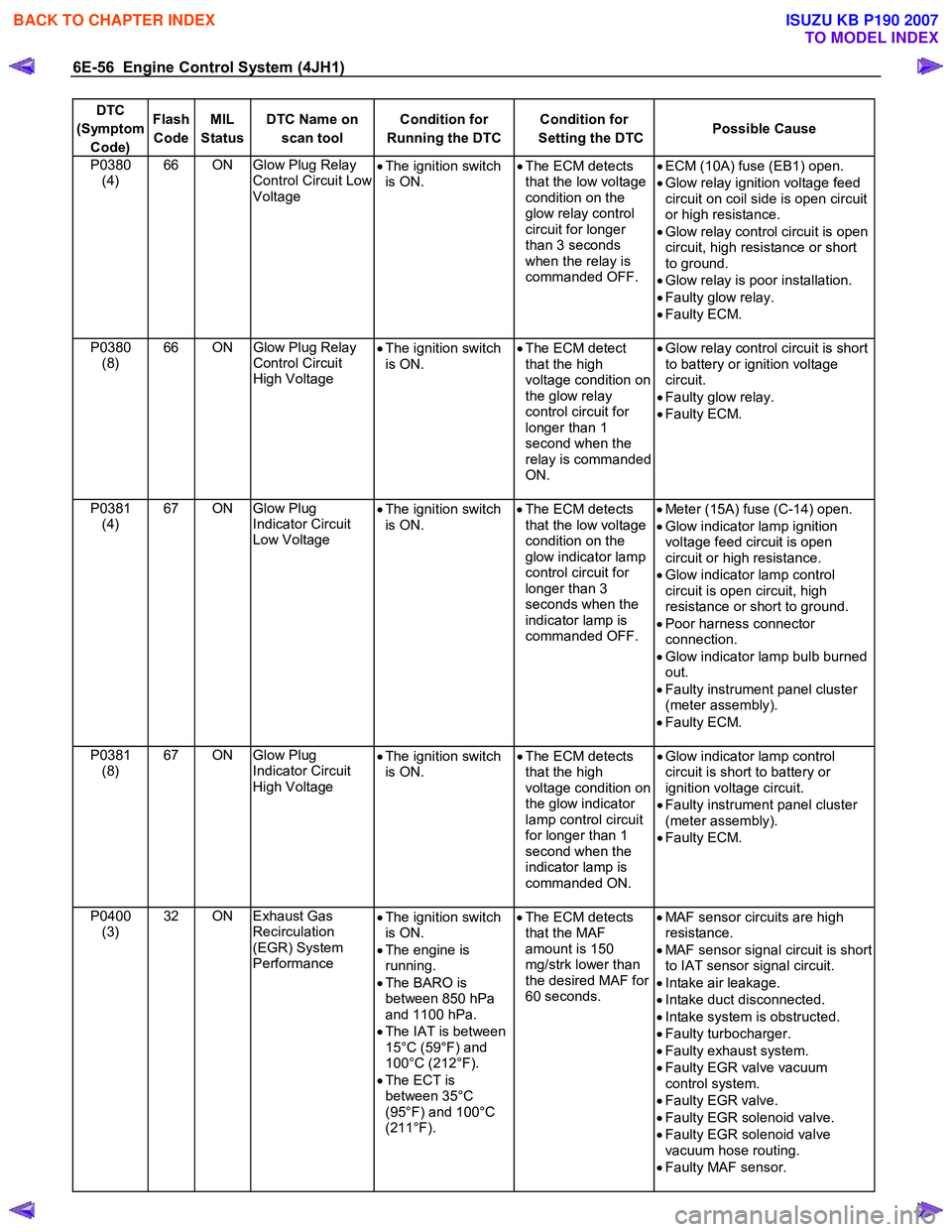
6E-56 Engine Control System (4JH1)
DTC
(Symptom Code) Flash
Code MIL
Status DTC Name on
scan tool Condition for
Running the DTC Condition for
Setting the DTC Possible Cause
P0380
(4) 66 ON Glow Plug Relay
Control Circuit Low
Voltage •
The ignition switch
is ON. •
The ECM detects
that the low voltage
condition on the
glow relay control
circuit for longer
than 3 seconds
when the relay is
commanded OFF.
•
ECM (10A) fuse (EB1) open.
• Glow relay ignition voltage feed
circuit on coil side is open circuit
or high resistance.
• Glow relay control circuit is open
circuit, high resistance or short
to ground.
• Glow relay is poor installation.
• Faulty glow relay.
• Faulty ECM.
P0380 (8) 66 ON
Glow Plug Relay
Control Circuit
High Voltage •
The ignition switch
is ON. •
The ECM detect
that the high
voltage condition on
the glow relay
control circuit for
longer than 1
second when the
relay is commanded
ON.
•
Glow relay control circuit is short
to battery or ignition voltage
circuit.
• Faulty glow relay.
• Faulty ECM.
P0381 (4) 67 ON Glow Plug
Indicator Circuit
Low Voltage •
The ignition switch
is ON.
•
The ECM detects
that the low voltage
condition on the
glow indicator lamp
control circuit for
longer than 3
seconds when the
indicator lamp is
commanded OFF.
•
Meter (15A) fuse (C-14) open.
• Glow indicator lamp ignition
voltage feed circuit is open
circuit or high resistance.
• Glow indicator lamp control
circuit is open circuit, high
resistance or short to ground.
• Poor harness connector
connection.
• Glow indicator lamp bulb burned
out.
• Faulty instrument panel cluster
(meter assembly).
• Faulty ECM.
P0381 (8) 67 ON Glow Plug
Indicator Circuit
High Voltage •
The ignition switch
is ON. •
The ECM detects
that the high
voltage condition on
the glow indicator
lamp control circuit
for longer than 1
second when the
indicator lamp is
commanded ON.
•
Glow indicator lamp control
circuit is short to battery or
ignition voltage circuit.
• Faulty instrument panel cluster
(meter assembly).
• Faulty ECM.
P0400 (3) 32 ON Exhaust Gas
Recirculation
(EGR) System
Performance •
The ignition switch
is ON.
• The engine is
running.
• The BARO is
between 850 hPa
and 1100 hPa.
• The IAT is between
15°C (59°F) and
100°C (212°F).
• The ECT is
between 35°C
(95°F) and 100°C
(211°F).
•
The ECM detects
that the MAF
amount is 150
mg/strk lower than
the desired MAF for
60 seconds.
•
MAF sensor circuits are high
resistance.
• MAF sensor signal circuit is short
to IAT sensor signal circuit.
• Intake air leakage.
• Intake duct disconnected.
• Intake system is obstructed.
• Faulty turbocharger.
• Faulty exhaust system.
• Faulty EGR valve vacuum
control system.
• Faulty EGR valve.
• Faulty EGR solenoid valve.
• Faulty EGR solenoid valve
vacuum hose routing.
• Faulty MAF sensor.
BACK TO CHAPTER INDEX
TO MODEL INDEX
ISUZU KB P190 2007